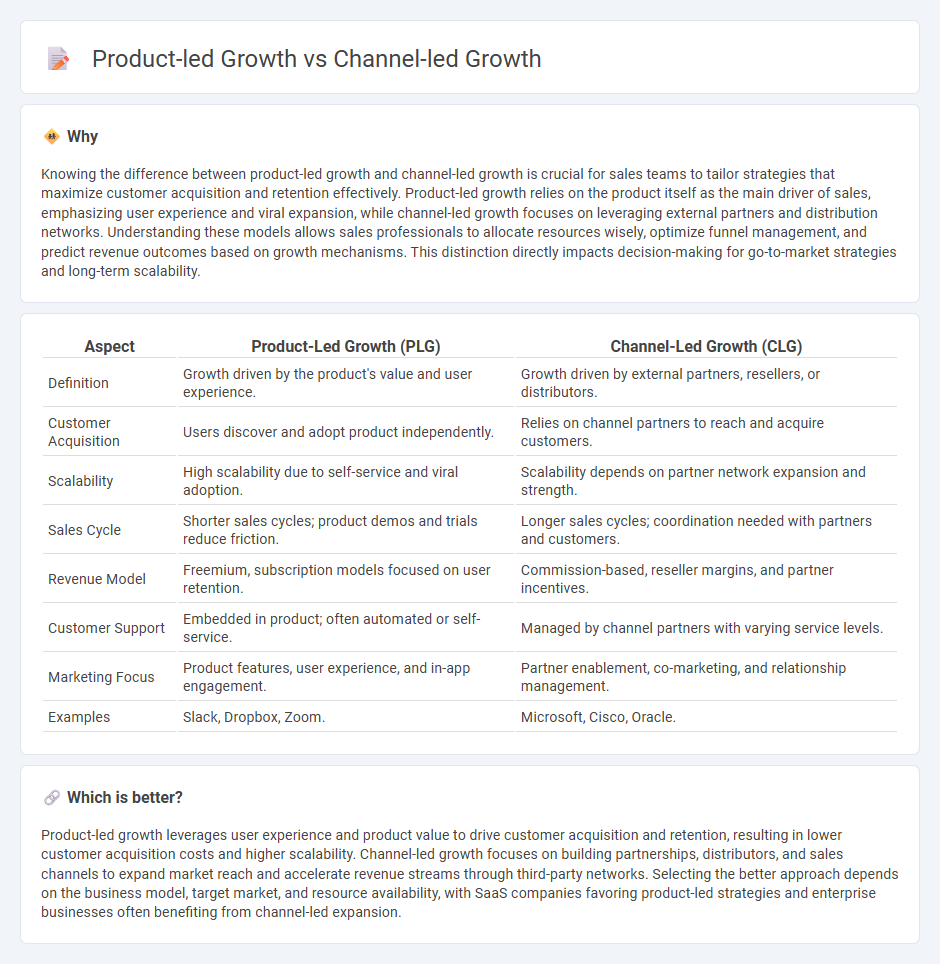
Product-led growth leverages the product itself as the primary driver for customer acquisition, expansion, and retention, emphasizing user experience and seamless onboarding. Channel-led growth relies on external partners, resellers, or affiliates to distribute and promote the product, focusing on expanding market reach through established networks. Explore the strategic nuances and benefits of each approach to optimize your sales growth.
Why it is important
Knowing the difference between product-led growth and channel-led growth is crucial for sales teams to tailor strategies that maximize customer acquisition and retention effectively. Product-led growth relies on the product itself as the main driver of sales, emphasizing user experience and viral expansion, while channel-led growth focuses on leveraging external partners and distribution networks. Understanding these models allows sales professionals to allocate resources wisely, optimize funnel management, and predict revenue outcomes based on growth mechanisms. This distinction directly impacts decision-making for go-to-market strategies and long-term scalability.
Comparison Table
| Aspect | Product-Led Growth (PLG) | Channel-Led Growth (CLG) |
|---|---|---|
| Definition | Growth driven by the product's value and user experience. | Growth driven by external partners, resellers, or distributors. |
| Customer Acquisition | Users discover and adopt product independently. | Relies on channel partners to reach and acquire customers. |
| Scalability | High scalability due to self-service and viral adoption. | Scalability depends on partner network expansion and strength. |
| Sales Cycle | Shorter sales cycles; product demos and trials reduce friction. | Longer sales cycles; coordination needed with partners and customers. |
| Revenue Model | Freemium, subscription models focused on user retention. | Commission-based, reseller margins, and partner incentives. |
| Customer Support | Embedded in product; often automated or self-service. | Managed by channel partners with varying service levels. |
| Marketing Focus | Product features, user experience, and in-app engagement. | Partner enablement, co-marketing, and relationship management. |
| Examples | Slack, Dropbox, Zoom. | Microsoft, Cisco, Oracle. |
Which is better?
Product-led growth leverages user experience and product value to drive customer acquisition and retention, resulting in lower customer acquisition costs and higher scalability. Channel-led growth focuses on building partnerships, distributors, and sales channels to expand market reach and accelerate revenue streams through third-party networks. Selecting the better approach depends on the business model, target market, and resource availability, with SaaS companies favoring product-led strategies and enterprise businesses often benefiting from channel-led expansion.
Connection
Product-led growth leverages the product itself as the primary driver of customer acquisition, expansion, and retention by emphasizing user experience and value. Channel-led growth complements this by utilizing external partners, distributors, or sales channels to scale market reach and accelerate revenue generation. Integrating both strategies creates a synergistic sales approach that maximizes market penetration and optimizes customer lifecycle value.
Key Terms
Distribution Channels
Channel-led growth emphasizes leveraging external partners such as resellers, distributors, and affiliates to scale product reach and accelerate revenue through established networks. Product-led growth centers on the product itself as the primary driver of user acquisition, engagement, and retention, relying on seamless onboarding and user experience to fuel organic expansion. Explore in-depth strategies and metrics to optimize your growth model for maximum impact.
User Onboarding
Channel-led growth emphasizes leveraging external partners and distribution networks to accelerate user acquisition and onboarding, often resulting in faster market penetration. In contrast, product-led growth relies on the product's inherent value and seamless onboarding experience to drive user adoption and retention organically. Explore the nuances of user onboarding in channel-led versus product-led strategies to optimize your growth approach.
Sales Enablement
Channel-led growth emphasizes leveraging partnerships and external sales channels to accelerate market expansion, driving revenue through collaborative networks and reseller engagement. Product-led growth centers on the product itself as the primary driver of customer acquisition, using features and user experience to facilitate organic growth and reduce reliance on traditional sales efforts. Explore the strategic advantages and implementation tactics of each growth model to optimize your sales enablement approach.
Source and External Links
Product led growth examples to inspire you - Channel-led growth involves partnering with third-party entities to distribute and sell products, leveraging partners' established networks and expertise to expand reach without requiring a large internal sales or marketing team, with success dependent on strong collaboration with channel partners.
Fuel Growth Podcast: Succeeding with Channel-Led Growth - Channel-led growth uses a strategic, integrated approach combining partners, influencers, marketing, and distribution networks to create unified messaging across channels, facilitating a seamless and consistent customer journey and helping companies grow their customer and partner base effectively.
Unlock partner-led growth for channel organizations - Partner-led growth requires thoughtful partnerships focusing on quality and alignment with internal teams, involving strategic collaboration, data exchange, and building trust, evolving a company's success increasingly through strategic channel partnerships as part of the organizational fabric.
 dowidth.com
dowidth.com